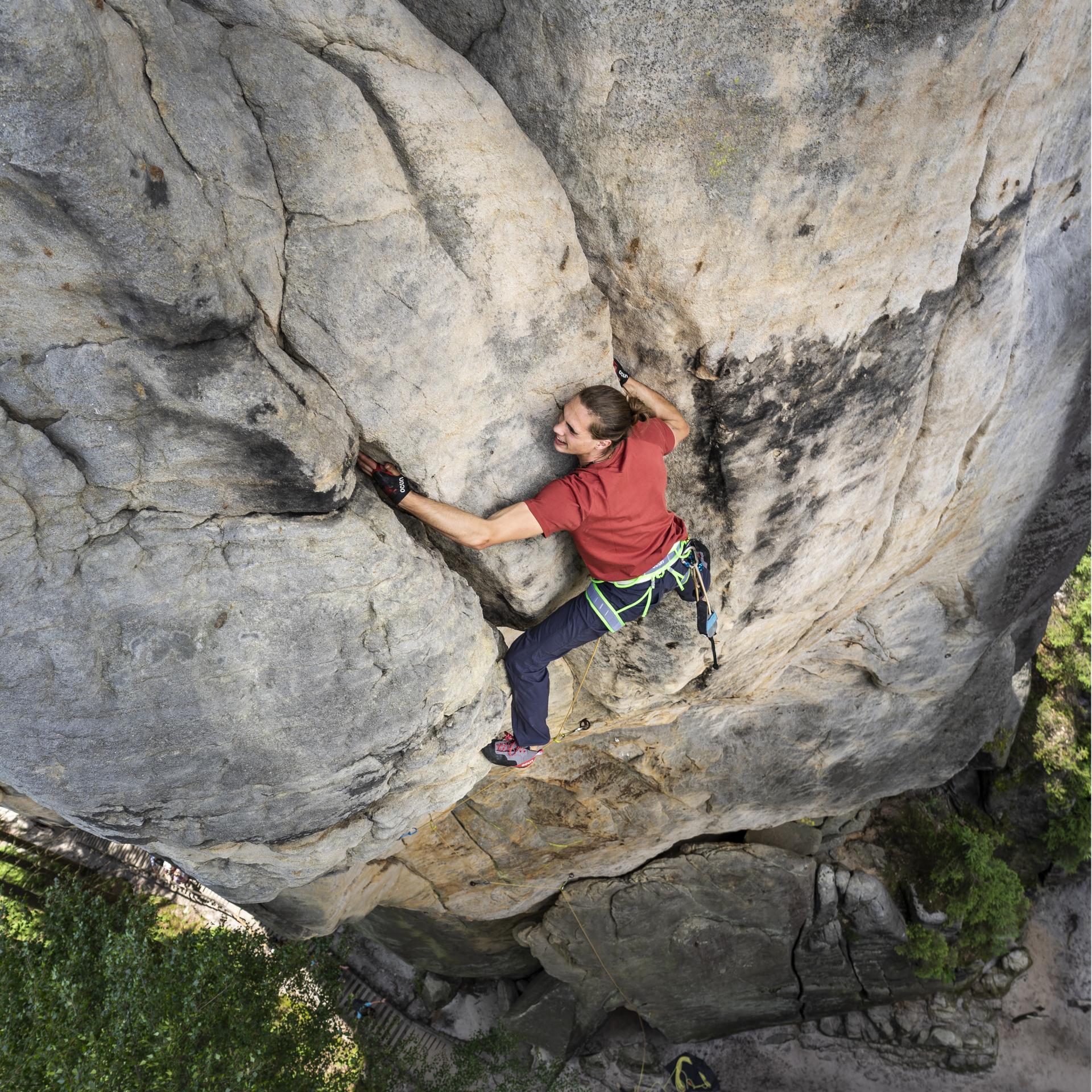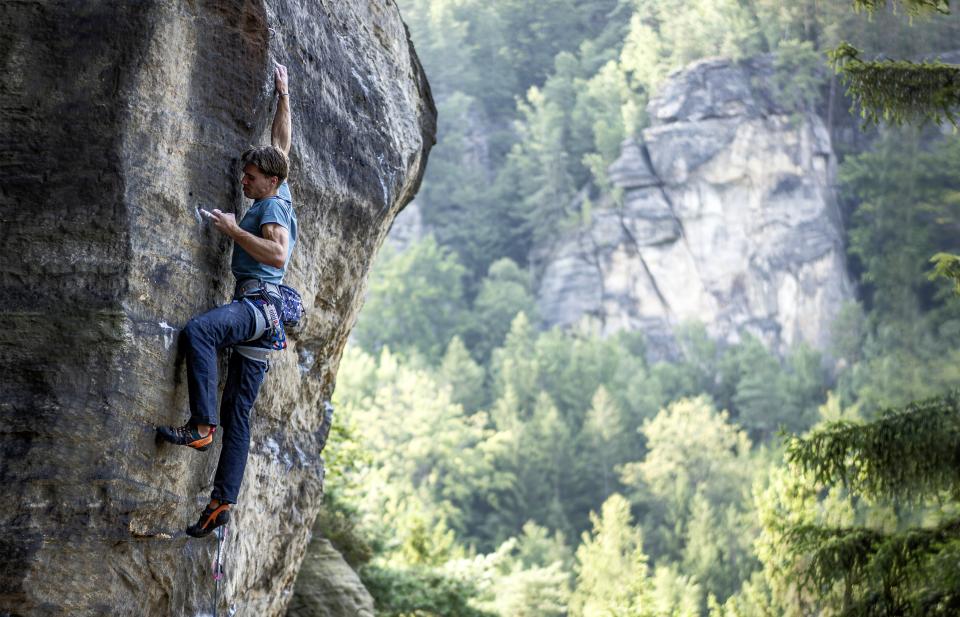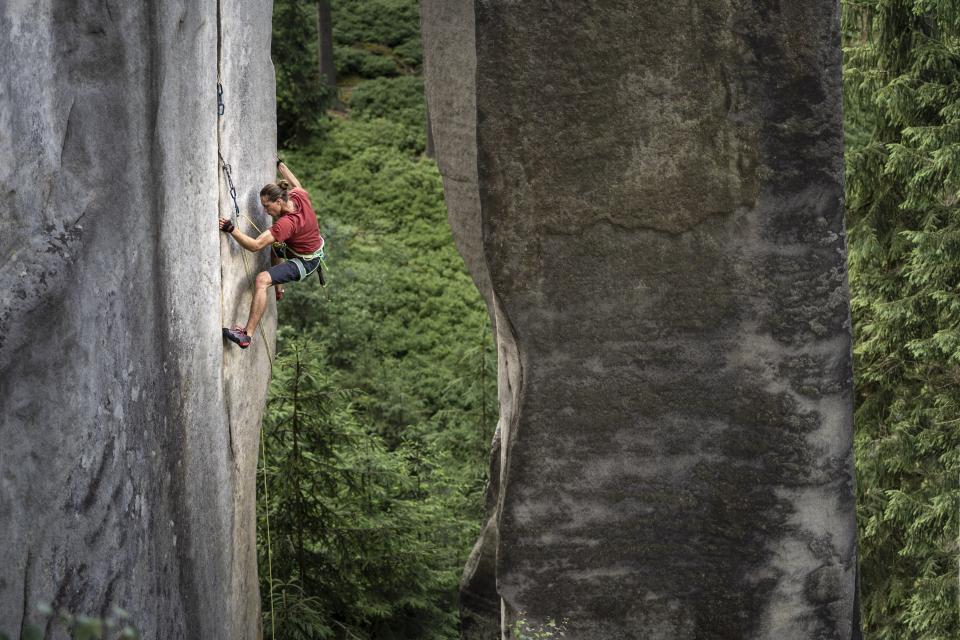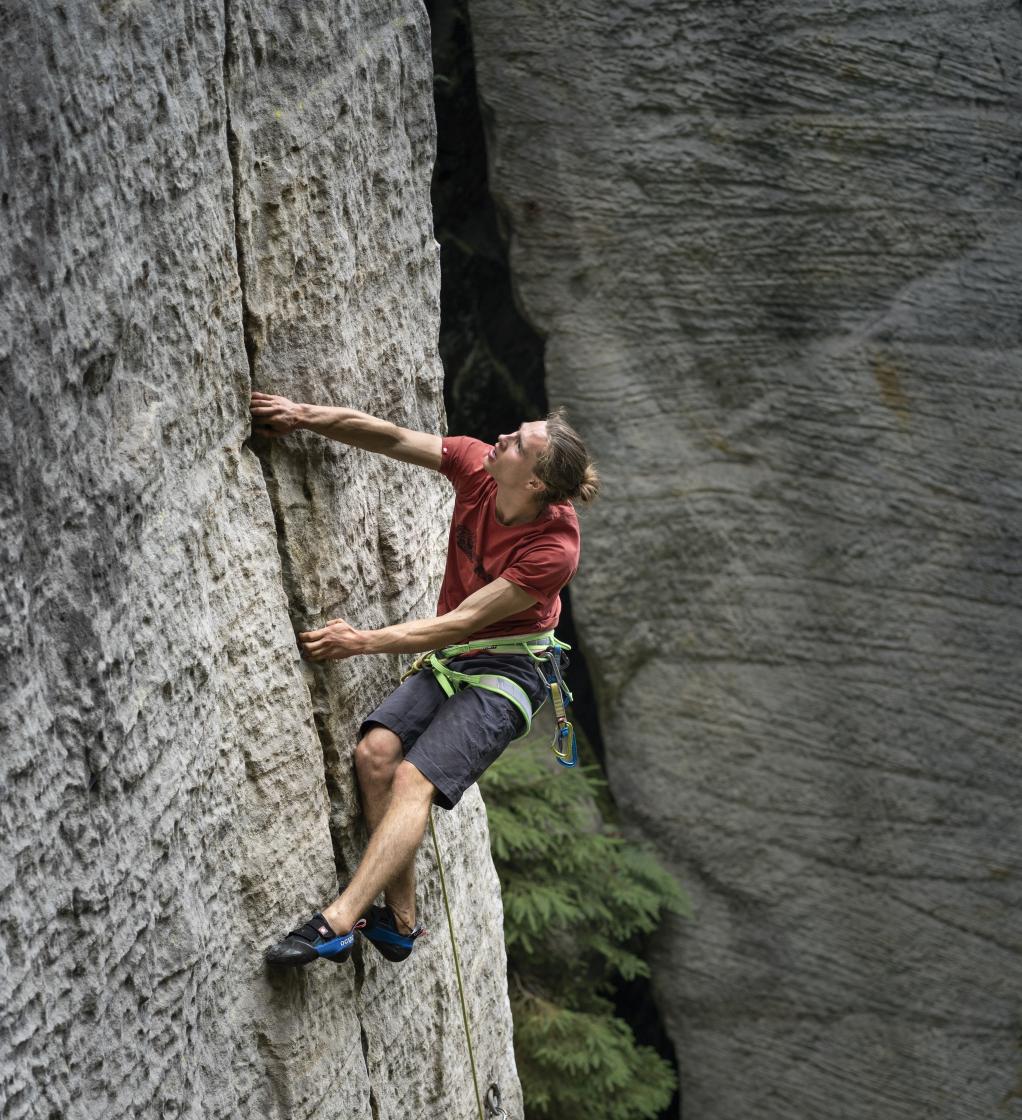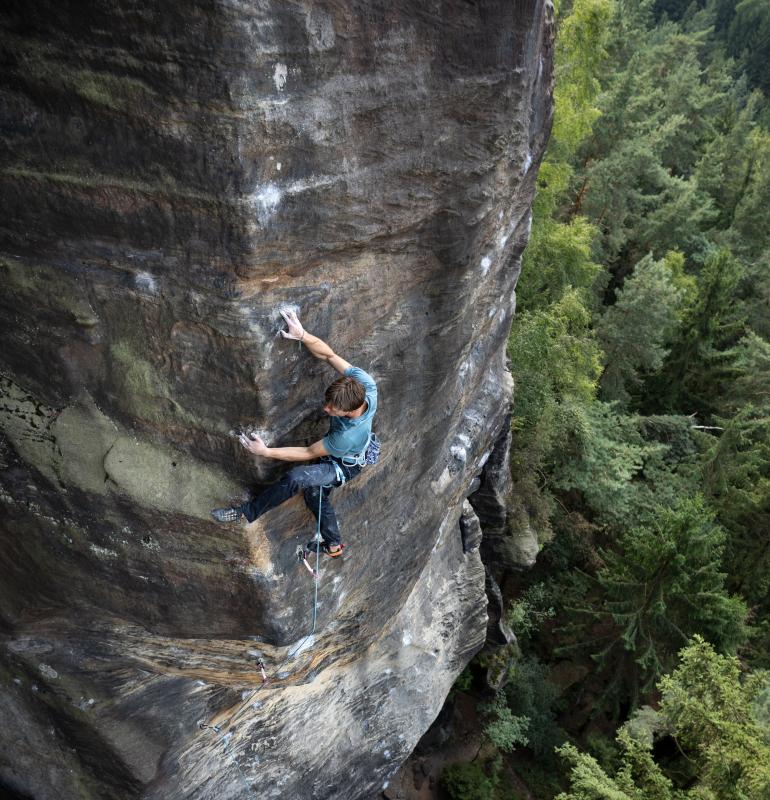He is a great and young climber from Ústí nad Labem. A guy who has been climbing since he was a kid and focuses mainly on sport climbing and bouldering. Honza's performance is still going up and he has already climbed routes of 8b French grading scale and also lines on Czech sandstones in classification Xc (French 8a).
Hey, Honza, for those who don't know you:
Why do you climb and what does climbing give you? If you will not climb, what else would you do? What are your other interests?
I climb mainly because I have been led to it since I was a child and I'm used to this specific climbing lifestyle that is associated with it. It also pushes me in my personal life, whether it's a matter of discipline, courage or patience and of course then the physical benefits. It's tempting to say that climbing gives me a life, which is partly true, but on the other hand I'm the kind of person who likes to explore, so I try to learn other new activities from time to time.
For example, I took karate classes on elementary school, I still play the piano and I occasionally ride skateboard or just go for a walk into nature. Climbing means a lot to me, but I find a great pity to fixate just on one thing in your life, because then life loses a bit of colours for me. And all these other non-climbing activities add some extra colours...
“Climbing means a lot to me, but I find it a great pity to fixate just only on one thing in life, because then life loses a little bit of colours for me...”
You are from Ústí nad Labem. How much time did you spend with climbing in the Elbe Valley? Were you drawn to the sandstone climbing since you were a child or did your parents just “drag” you there?
I was born in Ústí, but I basically have a "double home". One is in Ústí nad Labem, where I spend the most of my time, mainly because of a school. The other one is in Tisá, where I spend my weekends. Because of my second home in Tisá, I certainly climbed the most there and then in the surrounding areas such as Rájec and Ostrov.
Labák was mysterious to me in an obscure way and I was afraid of it as a child, but over time this feeling subsided and I began to like it more and more, and accordingly I started climbing there more and more. In our family there was nothing like "you want or you don't want to". Simply, when parents decided that we are heading to the rocks, it was done. Sometimes I wanted less, sometimes more, but regardless of whether one or the other option was valid, there was always a kind of "drive" and inner feeling that I felt good from the bottom of my heart in the rock climbing environment.
What kind of relationship do you have with your sister Edita Vopatová, who is also a great women Czech climber and recently she also done her first Xc in her home sandstone area – Tisá? Are you going to the crags together and are you “rivals” or rather support to each other?
Editka and I climbed a lot together. Sport climbs, multi-pitches in the Alps or even in the Jordanian desert Wadi Rum. We've never had a major crisis during these times and that speaks about our healthy and harmonious sibling relationship. Editka has inspired me in many ways and has been my role model since my childhood. We motivate each other during common training and even more in the rocks. He is a partner with added value and I am extremely grateful for such a sister who often reminds me an inexhaustible oasis of positive energy.
How is climbing in Labák specific compared to other Czech sandstone areas?
I have discussed this question with so many climbers and each one has always said something different. It is quite individual, but in general there is a compact face climbing, where you can find a great “lines od edges” and Labák is well bolted for typical Czech sandstone conditions. Sports climbers will certainly enjoy the best here in comparison to other sandstone rock climbing areas in the Czech. There are mostly longer lines with slopy crimps, where properly mastered climbing technique is a huge advantage and good endurance is an absolute must…
Do you see Labák as a world-class climbing destination, since many pro-climbers have already tried the local sandstone there?
Maybe because of the visit of some of these climbing-pros it is starting to look like a world-class area, but from my point of view: the fact that a few elite climbers came there, still does not make it a world destination. Labák certainly has potential, but it is still subjectively poorly secured for so many people, so it forms a kind of imaginary barrier against groups of foreign climbers wanted to come there. Thanks to this, I think that this potential will remain unfulfilled for some time, and it is probably right this way.
“Labák has definitely a potential, but because it is still poorly secured for so many people, it forms an imaginary barrier against larger groups of foreign climbers wanted to come here. And that's probably right."
What are currently the most difficult routes in the valley? What can I find on the right and on the left bank?
On the left bank „To tu ještě nebylo“ RP XIIb (This hasn't been here yet, 9a), which is an uncompromising and strength-endurance 16 meters line with approximately only six RP ascents so far, and overall it is the most difficult route in the whole valley. The second most difficult route is „Betom“ RP XIc (8c). The line leads along the wall on pretty small holds and it really takes a decent portion of endurance!
On the right bank, the hardest route is the “Černá Perla” XIIa (Black Pearl, 8c+). An incredible 40 meters long climb, after which all the hormones of happiness wash away. Right after "Pearl", we can consider that „Strandcafe“” RP XIc (8c) takes the place of the second most difficult route on the right bank. It is located right next to the “Pearl”, but it is much shorter and the key to this route is a difficult boulder problem.
On the left bank you climbed the „Hardcore“ RP Xc route (French 8a) on the Ďáblova stěna (Devil's Wall) in Mordor. How much time did you spend practicing this route and what are its biggest difficulties? How many RP climbs and repeats does the route already have?
Most routes in tenth grade took me just a few tries, so even “Hardcore” I sent in about five tries, when the crux was the long move in the part where it is the most overhanging. SPOILER-ALERT: In this 15 meters line, you have to fly quickly through the beginning, which always takes a little bit of your strength, and climb under the hardest part of the steepest section while you are still “fresh”. Then you have to fight hard in the boulder problem above with a long stretchy-move and at the end of the route you just don't to “give up”.
The route has quite a lot of ascents, about forty. It is very often climbed route, loved by some and hated by others. I'm in favour of the first option and for someone who doesn't like endurance routes, this boulder line is a lifesaver.
Are you trying any other hard routes in the valley now? Do you have any unclimbed projects?
I have currently chosen the mentioned “Černá perla” XIIa (Black Pearl, fr. 8c+) on the right bank as my project. It is climb on an amazing piece of rock called „Kormidelník“ (The Helsman) and for me it is one of the nicest and hardest routes I have ever tried.
What about training, Honza? Do you have a fixed structure or do you follow only some general recommendations based on yours years of experience? What exactly from the training itself may be useful when climbing outdoors on the sandstone?
I plan training sessions myself and follow the advices I received throughout my whole climbing career. I have already noticed what suits best for me and I always try to work on my weakness that I currently have. I also consider rock climbing itself as training, which is an important part of the entire training process for preparing for a rock climbing projects. This can also be reflected in climbing on sandstones, especially in the terms of your technique.
“I consider also rock climbing as a training itself, which is an important part of the entire process of preparing for the climbing projects.”
What would you recommend to all enthusiastic climbers – newbies, who would like to visit Labák, but are just starting out with sandstone climbing? What could help them most in their "first sandstone steps"?
It certainly requires a solid climbing history and experiences, both in the gym and also in the rocks. Labák is still not an area where the routes are secured like in Frankenjura or other sport climbing areas in Europe. Having some practice and having a little bit of technique is the basis for a level of confidence that is crucial for sandstone climbing. It definitely also requires wise and judgment, so that you can estimate when the route is beyond your strength and react accordingly to it. For a person who is going to climb in Labák for the first time with no rock (and little sandstone) climbing experience, I would recommend underestimating yourself a bit, rather than flying off into the bushes under the first clip with overconfidence and, in the worst case scenario, not even having an “after-climb beer” at legendary pub – U Kosti.
Do you have any favourite routes and tips for “recommendable” lines or sectors? Where the recreational climber will enjoy climbing and where the more advanced (performance oriented) climber enjoy climbing the most?
For “recreational climbers” I would recommend the “Malý Ďábel”sector on the left bank. Routes like “Zlaté listí” RP VIIIa (Golden leaves) or “Bacha na trpaslíky“ RP VIIIa (Watch out for dwarves). These are nice climbs on compact rock holds and pretty well secured. Just around the corner is the well-known route „Tvrdolín“ RP IXc (Stubborn), then also a lot of routes in tenth grade and for the biggest crushers the most difficult route on the Czech sandstones “To tu ještě nebylo” RP XIIb (This hasn't been here yet). I would also recommend the sector “Bleší trh“for climber's novice, where there are many beautiful routes of a lower difficulty classification. For more advanced individuals I would say go to the “Mordor“ sector. These mentioned places could be such a good “starting point”.
Your favourite classic, traditional route in Labák? Regardless of difficulty. Just a line that, for whatever reason, has burned into your memory?
I've always really liked the “Vodní svět” (Water World) route on the left bank. “Vodní svět” contains both harder moves in the wall (and even a one “mono-finger pocket”) as well as climbing on the edge, which is why it is my favourite and the most interesting route that I have ever climbed in Labák due to its style diversity.
What are your personal feelings and impressions of climbing in the Elbe Valley?
Climbing in Labák is always a “heart issue” and I generally enjoy climbing here. Every time I meet nice people and there is such a pleasant atmosphere. In short, Labák is exceptional, both in terms of its location and the climbing itself. After every route, you can look around at the wonderful valley and the view from the top, whether you send or not, is always warmly pleasing.
“Climbing in Labák is always a “heart issue”. I always meet nice people and there is such a nice atmosphere. Labák is simply exceptional because of its location and the climbing itself…”
And yours biggest climbing dreams? What have you been carrying in a head for a long time? What would you like to experience or fulfil one day?
I've been drawn to Yosemite for a long time, specifically to Separate Reality. A legendary ceiling crack with a rich climbing history. I also have a lot of thoughts about the Alpine Trilogy, which are three multi-pitch routes in the Alps, all with a difficulty 8b+. So far from the Czech climbers, only one man – Ondra Beneš, has climbed them all. Yeah, well in sport climbing I want to break the barrier of ninth grade and send 9a finally!
Honza, thanks a lot for your time and for this great interview. J
Want to know more about Honza's home area? Read the article Czech Sandstone Paradise "LABÁK"
